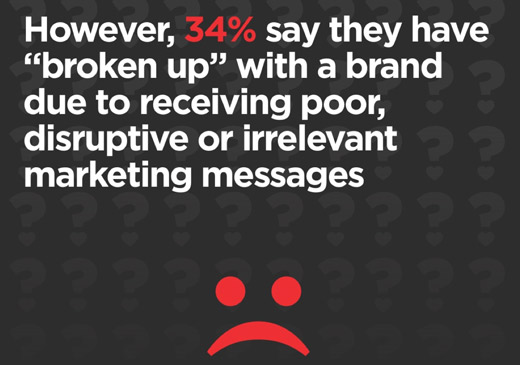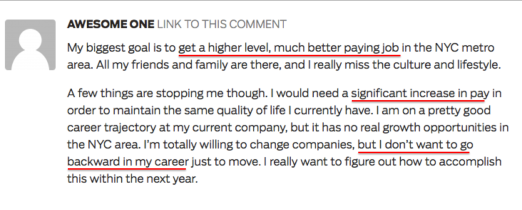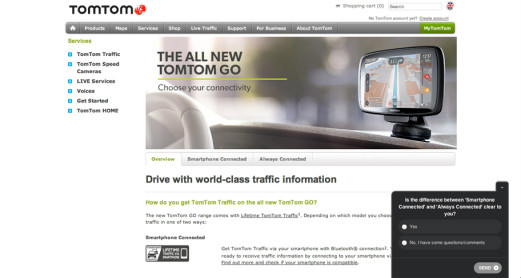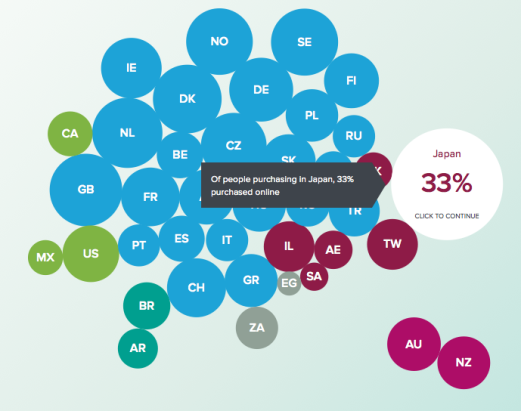How well do you know your customers? Do you know where they spend their time online, their average annual income or revenue, and their biggest problems relevant to your solution? How about how they take their coffee?
(Ok, maybe that last one is a little excessive.)
If you answered “pretty well” or “not so well,” then take a moment and let this statistic sink in: 46% of 20,000 consumers surveyed across 20 countries broke up with a brand because they were receiving “irrelevant content pushes.” That’s a lot of lost customers simply because a company didn’t do its research properly.
If you answered “I know my customer inside-out,” that’s great! But keep in mind that this isn’t a guessing game; simply putting yourself in your customer’s shoes for a few minutes and imagining how they think and feel isn’t enough. The only way to truly understand them is through deep, ongoing research. One-on-one conversations––whether over the phone, on Skype or over coffee––are often the most effective ways to get inside your target market’s head, and if you’re just getting started with customer research, I recommend this as your first step.
Unfortunately, this method is time-consuming and not very scalable if you want to collect data from lots of people. That’s where online research comes in; it can help you round out the information you’ve collected during your one-on-one’s, and it’s a great way to flush out your customer personas. It can also help product managers get the feedback they need in order to create better products.
So where can you go online to learn about your customers? While this will be unique to each company––it depends largely on where your customers spend their time online––I’m going to go over the websites, tools, and techniques that have proven most effective for me when conducting online research about a target market.
Quora
Quora is a great place for research because it revolves around people holding in-depth conversations about a broad range of topics, from social media to startups to ethnic junk food. Type a keyword or phrase related to your product in the search box and you’ll be served a long list of conversations, at least some of which will reveal how your target market is thinking about things related to your business.
For example, let’s say you’re building a social media marketing tool and you want to find out more about what’s on community managers’ minds. You can search “social media” and immediately see a list of questions related to your product.
A quick glance at the list of questions tells you a lot: the post about measuring ROI from social media has been upvoted 61 times and answered over 100 times, so it’s clear this topic is on people’s minds (same with improving your social media presence in general). Although the question was posted in 2011, people are still posting answers to it in 2019!
Click on one of the topics and you’ll see rich dialogue and input from people who represent your target market.
The thread above teaches you that measuring the ROI of social media is a major pain point for professionals in the space, that there are many ways to measure it, and that different responders will give very different answers. Good to know; maybe you should write a blog post about it, publish an ebook or host a webinar. Also, the responder seems pretty smart; you can research him a bit more and see if you should invite him to write a guest post on your blog.
Keyword research
As Copyblogger points out in their guide (it’s free to sign up and receive a copy), keyword research isn’t just about SEO. At its essence, it’s market research––“It tells you what people are interested in and in what relative numbers,” and “it reveals the actual language people are using when they think about those topics, which provides you with insight on how to converse with them via your blog.”
Page 14 of their guide breaks down exactly how you can interpret keyword research to better understand your niche, identify which kind of business/product/service/blog would generate traffic or money, and determine what kinds of content would get the attention of your audience.
Whenever I do interviews with people representing a specific target market I like to ask them what terms they would put in Google to find information related to the industry, product or service. This gives me a few keywords and phrases (that I might not have thought of before) to start playing with in my keyword research.
Blog comments
There are a couple ways to use blog comments for research. If you have a successful blog that gets a number of comments per post, reading through the comments can give you insights into your target market’s key pain points.
Entrepreneur and super-successful blogger Ramit Sethi often gets hundreds of comments on his blog posts, and he encourages people to make these comments useful and meaningful by ending his articles with a prompt for the reader to respond to.
For example, the prompt below garnered 247 responses in the comments section.
Comments such as the one below offer a wealth of information about what’s on the minds of Ramit’s readers; now he can look to see if a better-paying job and more prestigious title are something other commenters want and then start to think about content or products that he can build around this (in Ramit’s case, he’s already done this).
You can also browse comments on popular industry blogs, articles relevant to your field or on your competitions’ blogs and look for common threads. Let’s say I’m building a course on finding a dream job (say you work or operate an online recruitment site) and Ramit is one of my main competitors––his blog comments are a gold mine of insights into my target customer’s psychology.
Surveys
Long-form surveys with a survey tool like SurveyMonkey are another great option for online customer research. Once you’ve created your survey, you can send the link to your mailing list subscribers, post it on your blog and share it in social media. Keep in mind that the response rate for surveys like these tends to be pretty low, so companies with larger audiences are more likely to get enough information to formulate meaningful insights.
In order to increase your response rate, you can offer incentives, like a free Starbucks gift card or a chance to win an iPad. You can also pay people to take your surveys––some survey software companies such as SurveyGizmo and SurveyMonkey offer to find people to take your survey based on your specified demographics.
Another increasingly-popular survey tactic is to place a short pop-up survey at the bottom of your website with an app like Qualaroo. This is great for testing product improvement ideas or confirming a hypothesis you have about your target market. Remember to keep it short––these pop-up surveys are most successful when you stick to one question.
This article talks about how to implement both kinds of surveys in more detail.
Progressive profiling on your forms
If you have a solid content marketing strategy in place and people are repeatedly visiting your site to download content, then you might as well take advantage of progressive profiling. Uh, what’s that? As Hubspot explains:
“Progressive profiling allows you to set up iterative forms that enable you to designate which questions appear based on what you already know about a particular lead. That way, every time a lead fills out a form, you are progressively collecting valuable new information about them while keeping your forms short and easy to complete.”
Over time you will collect enough data to paint a detailed picture of your subscriber or customer, focusing on information that helps you connect with them in a more meaningful way. Let’s revisit the social media marketing tool example––in this case, you can ask questions like, “What’s your biggest social media challenge?” or “What’s the one thing you most want to get out of your social media efforts?” and give a few possible answers in a multiple choice format.
Your competition’s website
Studying your competition’s web copy and blog content is another great way to identify what matters to your target market. Granted, there’s no guarantee that your competition’s messaging is based on thorough research, but common threads found in the copy and blog content across your competitors’ websites will point you in the direction of things your audience cares about.
This Copy Hackers ebook bundle includes a table for organizing your competitions’ messaging and pulling out similarities in the language and messaging.
Pay for research & data
There are many ways to conduct online research without paying a cent, but sometimes you’ll want to fork over a little cash to save time and get a more robust data set. GutCheck recruits people from a company’s target market to help them validate new product ideas, discover customer segments and test advertising concepts.
If you’re looking for people to conduct usability testing, UserTesting.com & Five Second Test allow you to get feedback from real people as they use your website or mobile app. This helps you cut down on the time it takes to find people to test and then get them set up in your office.
Free market research tools
Last but not least, there are several free market research tools that can help with your online market research. Consumer Barometer is a beautiful, interactive tool that gives you data on how consumers research items before purchasing, while U.S. Data and Statistics publishes government statistics such as demographic data for individual cities, states, and countries.
You can also access census data on the Census Bureau’s website, and the Census Bureau’s Quick Facts microsite gives you key demographic statistics pertaining to all fifty states.
Conclusion
Customer research shouldn’t be a one-time thing you do when you first create your marketing plan; ideally, it will be an integral part of your marketing strategy and product development process. The websites, communities, and resources above are just a few of the many places you can go to learn more about your target market.
Now I’d like to hear from you. Where do you go online to research your customers, and how often do you do it?
About the Author: Chloe Mason Gray specializes in digital marketing and growth strategy for startups and intrepid entrepreneurs. Be sure to say hi to her on Twitter.







Comments (9)